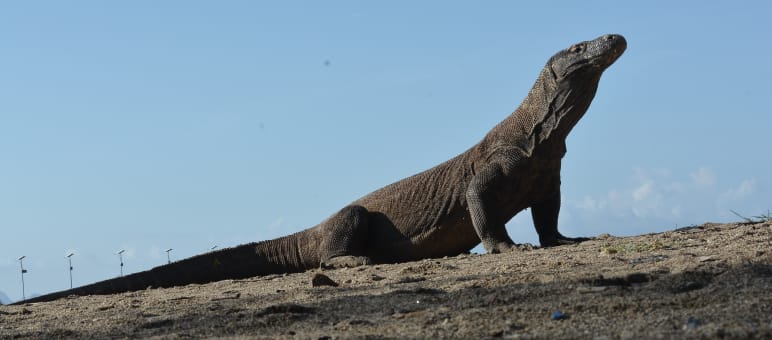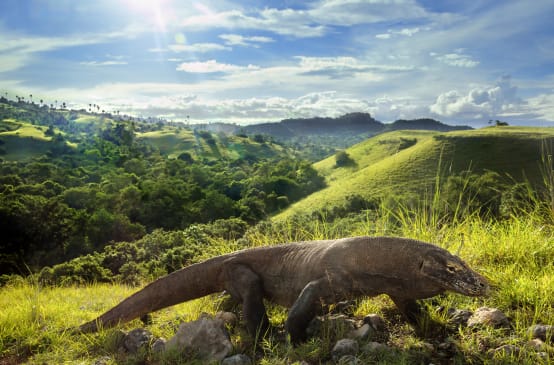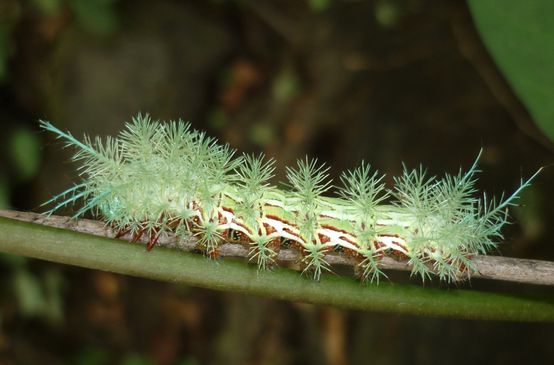
Indonesia: climate crisis threatens Komodo dragons
The International Union for Conservation of Nature (IUCN) is warning of the impending extinction of the Komodo dragons. The organization has classified them as “Endangered” on its new Red List of threatened animal and plant species – a list that is getting longer and longer due to the climate crisis.
Komodo dragons (Varanus komodoensis) live only in Komodo National Park, a UNESCO World Heritage Site, and on the neighboring island of Flores, in Indonesia. The estimated 3,000 individuals are the last of their kind. The world’s largest lizards are coming under increasing pressure from habitat destruction and wildlife trafficking, and climate change could now finish them off.
With our petition “NO to a ‘Jurassic Park’ for Komodo dragons!”, we collected more than 87,000 signatures speaking out against luxury tourism projects in Komodo National Park and the destruction of the last retreat of the dragons.
In August, as a result of worldwide protests, the UNESCO World Heritage Committee spoke out against the tourism projects because of the threat to the Komodo dragons’ habitat. The Committee called on the Indonesian government to submit a revision of the environmental impact assessment for the national park to UNESCO by September at the latest.
“This is a win against the destruction of a conservation area and World Heritage Site by the current regime’s tourism development,” says Kyoto University’s Center for Southeast Asian Studies researcher and environmentalist Cypri Jehan Paju Dale, who was born on Flores.
But the “Jurassic Park” is not the only threat the giant lizards face – a recent report by the International Union for Conservation of Nature (IUCN) concludes that rising sea levels caused by the climate crisis will drastically shrink their habitat. The organization has thus reclassified Komodo dragon from “Vulnerable” to “Endangered” on its Red List.
The example of the Komodo dragon shows the devastating consequences of the climate crisis with great clarity. According to the IUCN, increasing global temperatures and rising sea levels will reduce their habitat by at least 30 percent over the next 45 years. Komodo dragons living outside of protected areas on the island of Flores are particularly at risk.
While the population in Komodo National Park is relatively stable, the habitat on Flores Island shrank by more than 40 percent between 1970 and 2000 due to human influence, the IUCN noted.
Komodo dragons live in forests and open grassland. They cannot survive at altitudes above 700 meters. Thus, there is a risk that their numbers will be further decimated by rising sea levels if they have no choice but to move upland.
“The idea that these prehistoric animals have moved one step closer to extinction due in part to climate change is terrifying,” said Dr. Andrew Terry, conservation director of the Zoological Society of London. Last year, experts urgently called for conservation measures to prevent the Komodo dragon from becoming extinct.
The IUCN World Conservation Congress 2020 took place from 3 to 11 September 2021 in Marseille, France. The organization has more than 1,300 members, including ministries, environmental protection organizations and research institutions. The IUCN’s responsibilities include advising UNESCO on the designation and monitoring of Natural World Heritage sites.
At its congress, the IUCN presented its updated Red List, which places animal and plant species into nine categories: Not Evaluated, Data Deficient, Least Concern, Near Threatened, Vulnerable, Endangered, Critically Endangered, Extinct in the Wild and Extinct. In total, the list currently includes around 140,000 species, of which nearly 40,000 are threatened with extinction.

NO to a ‘Jurassic Park’ for Komodo dragons!
The Indonesian government wants to create a ‘Jurassic Park’ for luxury tourists – with no regard for the Komodo dragons, the stunning underwater world or local communities.

Biodiversity
Life on Earth originated around 4 billion years ago. Since then, an unfathomable number of species have evolved, around half of which are insects. Numerous plant and animal species have yet to be documented, and many new ones are being discovered every day.